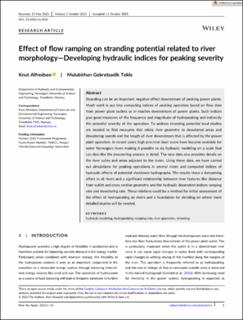| dc.contributor.author | Alfredsen, Knut Tore | |
| dc.contributor.author | Tekle, Mulubirhan Gebretsadik | |
| dc.date.accessioned | 2023-11-24T13:47:37Z | |
| dc.date.available | 2023-11-24T13:47:37Z | |
| dc.date.created | 2023-10-30T11:41:16Z | |
| dc.date.issued | 2023 | |
| dc.identifier.citation | Rivers Research and Applications: an international journal devoted to river research and management. 2023, . | en_US |
| dc.identifier.issn | 1535-1459 | |
| dc.identifier.uri | https://hdl.handle.net/11250/3104586 | |
| dc.description.abstract | Stranding can be an important negative effect downstream of peaking power plants. Much work is put into computing indices of peaking operation based on flow data from power plant outlets or in reaches downstream of power plants. Such indices give good measures of the frequency and magnitude of hydropeaking and indirectly the potential severity of the operation. To address stranding potential local studies are needed to find measures that relate river geometry to dewatered areas and dewatering speeds and the length of river downstream that is affected by the power plant operation. In recent years, high-precision laser scans have become available for some Norwegian rivers making it possible to do hydraulic modeling on a scale that can describe the dewatering process in detail. The new data also provides details on the river valley and areas adjacent to the rivers. Using these data, we have carried out simulations for peaking operations in several rivers and computed indices of hydraulic effects of potential shutdown hydrographs. The results show a dampening effect in all rivers and a significant relationship between river features like distance from outlet and cross section geometry and the hydraulic dependent indices ramping rate and dewatering rate. These relations could be a method for initial assessment of the effect of hydropeaking on rivers and a foundation for deciding on where more detailed studies will be needed. | en_US |
| dc.language.iso | eng | en_US |
| dc.publisher | Wiley | en_US |
| dc.rights | Attribution-NonCommercial-NoDerivatives 4.0 Internasjonal | * |
| dc.rights.uri | http://creativecommons.org/licenses/by-nc-nd/4.0/deed.no | * |
| dc.title | Effect of flow ramping on stranding potential related to river morphology—Developing hydraulic indices for peaking severity | en_US |
| dc.title.alternative | Effect of flow ramping on stranding potential related to river morphology—Developing hydraulic indices for peaking severity | en_US |
| dc.type | Peer reviewed | en_US |
| dc.type | Journal article | en_US |
| dc.description.version | publishedVersion | en_US |
| dc.source.pagenumber | 14 | en_US |
| dc.source.journal | Rivers Research and Applications: an international journal devoted to river research and management | en_US |
| dc.identifier.doi | 10.1002/rra.4224 | |
| dc.identifier.cristin | 2189882 | |
| cristin.ispublished | true | |
| cristin.fulltext | original | |
| cristin.qualitycode | 1 | |

